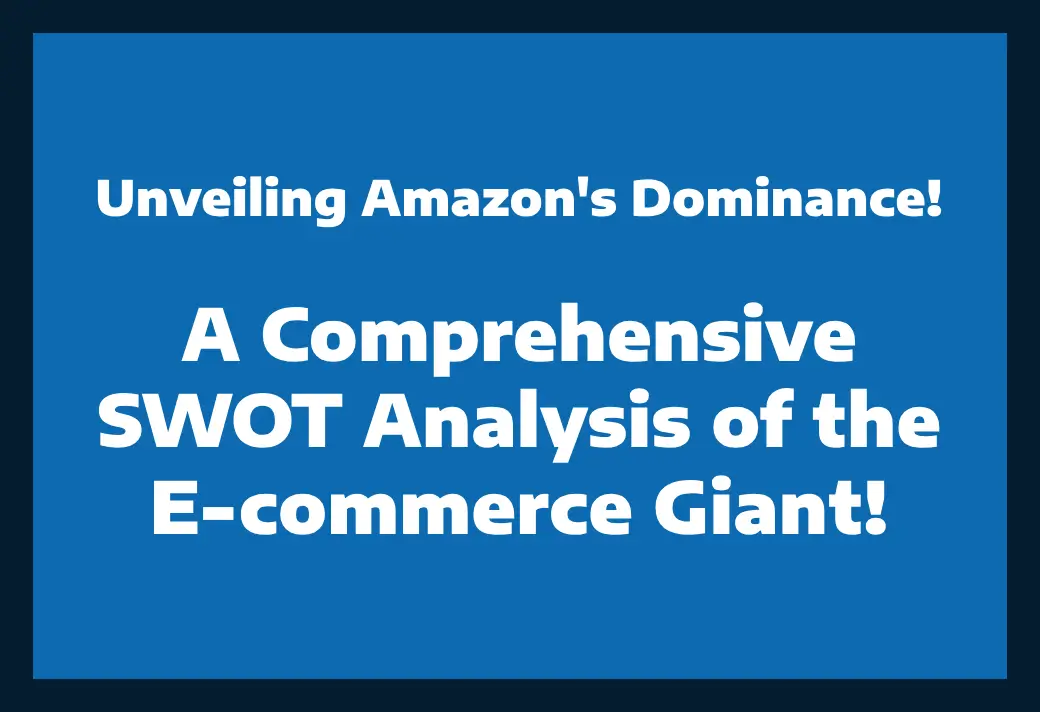In today’s digital era, Amazon has emerged as the unrivaled leader in the e-commerce industry. With its vast product selection, efficient logistics, and exceptional customer service, Amazon has revolutionized the way we shop online.
In this article, I will conduct a comprehensive SWOT analysis of Amazon, shedding light on its strengths, weaknesses, opportunities, and threats. By understanding the factors that contribute to Amazon’s dominance, we can gain valuable insights into the e-commerce landscape and learn from the company’s success.
What is a SWOT Analysis and Why is it Important?
A SWOT analysis is a strategic planning tool used to evaluate an organization’s internal strengths and weaknesses, as well as external opportunities and threats. By conducting a SWOT analysis, companies can identify areas of improvement, capitalize on their strengths, and mitigate potential threats. In the case of Amazon, a SWOT analysis will provide a holistic view of the company’s current position in the market and its future prospects.
Strengths of Amazon – An In-depth Analysis
Amazon’s strengths lie in its ability to deliver a seamless shopping experience to its customers. Firstly, Amazon boasts an extensive product selection, ranging from books and electronics to clothing and household items. This vast assortment of products attracts a wide customer base, ensuring that almost everyone can find what they need on the platform.
Secondly, Amazon has perfected its logistics operations. The company’s fulfillment centers and efficient delivery network enable them to offer fast and reliable shipping to customers worldwide. This seamless logistics system not only enhances customer satisfaction but also strengthens Amazon’s competitive advantage.
Thirdly, Amazon has built a strong brand image based on trust and reliability. The company’s commitment to customer service, hassle-free returns, and transparent pricing has earned the trust of millions of consumers. Amazon Prime, the company’s premium membership program, further enhances customer loyalty by offering exclusive benefits such as free two-day shipping and access to streaming services.
Weaknesses of Amazon – Uncovering Potential Vulnerabilities
While Amazon has numerous strengths, it also faces certain weaknesses that could pose challenges in the future. One weakness is the company’s heavy reliance on third-party sellers. Although this marketplace model allows Amazon to offer a vast product selection, it also exposes the company to risks such as counterfeit products and poor seller performance. Maintaining quality control and ensuring a positive customer experience becomes more challenging as the number of sellers on the platform increases.
Another weakness is Amazon’s vulnerability to negative public perception. As the company continues to grow, it faces scrutiny regarding its impact on local businesses, labor practices, and data privacy. Any negative publicity or regulatory actions can damage Amazon’s reputation and erode consumer trust, leading to potential loss of market share.
Lastly, Amazon’s international expansion has encountered some hurdles. The company faces competition from local e-commerce players in various countries, each with its own unique market dynamics. Adapting to local preferences, navigating regulatory frameworks, and building strong brand recognition in new markets can be challenging and time-consuming.
Opportunities for Amazon’s Future Growth and Expansion
Despite its dominant position, Amazon still has several opportunities for future growth and expansion. One significant opportunity lies in the emerging markets. As internet penetration increases and consumer purchasing power grows in countries like India, Brazil, and China, Amazon can tap into these untapped markets and capture a massive customer base. By tailoring its services and offerings to meet the specific needs of these markets, Amazon can secure a strong foothold in regions with significant growth potential.
Another opportunity lies in the realm of technological innovation. Amazon has already made significant strides with its smart home devices (such as Amazon Echo and Alexa), cloud computing services (Amazon Web Services), and drone delivery experiments. By continuing to invest in cutting-edge technologies and leveraging its vast data resources, Amazon can stay ahead of the competition and redefine the future of e-commerce.
Furthermore, Amazon has the potential to expand its reach beyond e-commerce. With its vast customer base and robust infrastructure, the company can explore new avenues such as healthcare, entertainment, and finance. By diversifying its business portfolio, Amazon can minimize its dependence on e-commerce and create new revenue streams.
Threats That Could Challenge Amazon’s Dominance
Despite its remarkable success, Amazon faces several threats that could challenge its dominance in the e-commerce industry. One significant threat is the intensifying competition from other tech giants. Companies like Walmart, Alibaba, and Google are ramping up their e-commerce efforts and investing heavily in technology, logistics, and customer experience. As these competitors continue to innovate and improve their offerings, they pose a formidable challenge to Amazon’s market share.
Another threat is the ever-changing regulatory landscape. Governments around the world are increasingly scrutinizing the practices of tech companies, especially in areas such as antitrust, taxation, and data privacy. Any regulatory actions or legal disputes can disrupt Amazon’s operations, leading to financial penalties, reputational damage, and loss of consumer trust.
Furthermore, Amazon’s reliance on third-party logistics providers poses a potential threat. While the company has established a robust logistics network, disruptions in the supply chain can occur due to factors beyond its control, such as natural disasters, labor disputes, or geopolitical tensions. Such disruptions can impact Amazon’s ability to deliver products to customers on time, leading to customer dissatisfaction and potential revenue loss.
A Comprehensive SWOT Analysis of Amazon
Strengths:
- Extensive product selection catering to a wide customer base
- Efficient logistics operations ensuring fast and reliable shipping
- Strong brand image built on trust and reliability
Weaknesses:
- Heavy reliance on third-party sellers and associated risks
- Vulnerability to negative public perception and reputational damage
- Challenges in international expansion and competition from local players
Opportunities:
- Expanding into emerging markets with growing internet penetration
- Investing in technological innovation to stay ahead of the competition
- Diversifying into new industries beyond e-commerce
Threats:
- Intensifying competition from other tech giants
- Regulatory scrutiny and legal disputes
- Disruptions in the supply chain and logistics operations
- Implications of Amazon’s Dominance on the E-commerce Landscape
Amazon’s dominance in the e-commerce industry has far-reaching implications for both consumers and businesses. On one hand, consumers benefit from the convenience, competitive pricing, and vast product selection offered by Amazon. The company’s focus on customer satisfaction and continuous improvement has raised the bar for the entire e-commerce industry, forcing competitors to improve their offerings and provide a better shopping experience.
On the other hand, Amazon’s dominance poses challenges for smaller businesses. The company’s vast resources, economies of scale, and aggressive pricing strategies make it difficult for smaller retailers to compete. Many traditional brick-and-mortar stores have struggled to adapt to the rise of e-commerce, and some have been forced to close their doors. However, businesses that embrace technology, focus on niche markets, and provide unique value propositions can still thrive in the Amazon-dominated landscape.
Lessons Businesses Can Learn from Amazon’s Success
Amazon’s success story offers valuable lessons for businesses of all sizes and industries. Firstly, customer-centricity is crucial. By prioritizing customer satisfaction and continuously improving the shopping experience, businesses can build strong brand loyalty and gain a competitive edge. Additionally, investing in logistics and supply chain management is vital for efficient operations and timely delivery. A seamless and reliable fulfillment process enhances customer satisfaction and strengthens a company’s position in the market.
Furthermore, businesses should embrace technology and leverage data to drive innovation and improve decision-making. Amazon’s use of artificial intelligence, machine learning, and big data analytics has been instrumental in enhancing its operations, personalizing the customer experience, and optimizing its logistics network. By harnessing the power of technology, businesses can streamline processes, gain valuable insights, and stay ahead of the curve.
Conclusion: The Future of Amazon and the E-commerce Industry
As Amazon continues to dominate the e-commerce industry, its future prospects remain promising. By capitalizing on its strengths, addressing its weaknesses, and seizing opportunities for growth and expansion, Amazon can further solidify its position as the global e-commerce leader. However, the company must also navigate the challenges posed by competitors, regulatory environments, and supply chain disruptions.
For businesses operating in the e-commerce landscape, understanding the factors behind Amazon’s success and embracing the lessons learned can pave the way for sustainable growth and success. By focusing on customer satisfaction, leveraging technology, and continuously evolving to meet changing market dynamics, businesses can thrive in the evolving e-commerce industry and carve out their own path to success.




